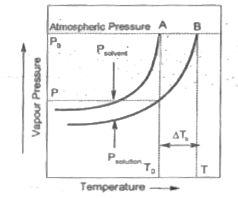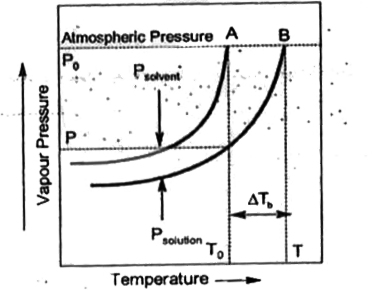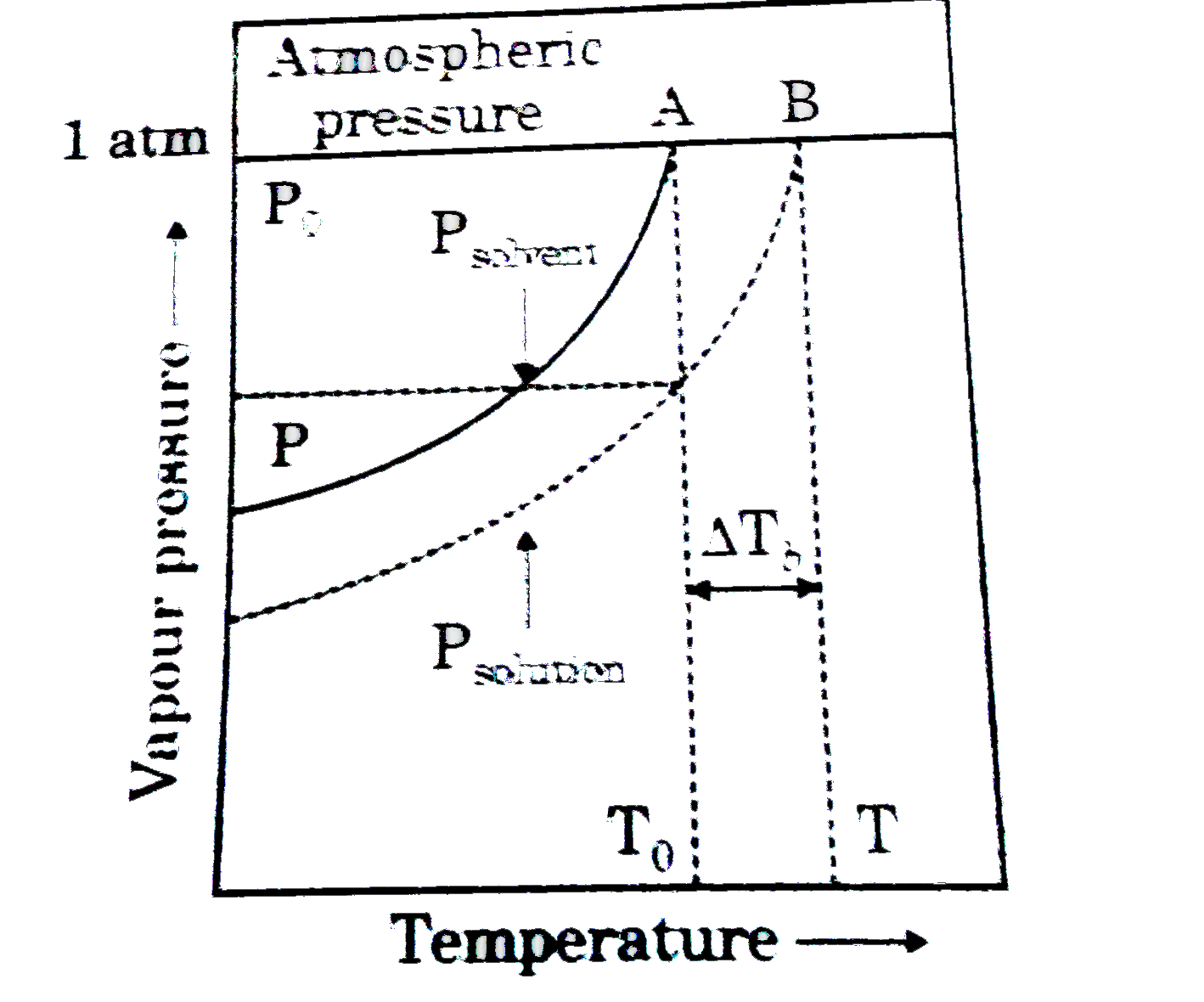A complex iron and cyanide ions is 100% ionised at 1 m (molal) . If its elevation in b.p is 2.08 . Then the complex is (Kb=0.52∘mol−1kg):
K3[Fe(CN)6]
Fe(CN)2
K4[Fe(CN)6]
Fe(CN)4
The correct Answer is:A
To solve the problem, we will follow these steps:
Step 1: Understand the given data
We are given:
- Boiling point elevation (ΔT_b) = 2.08 °C
- Molality (m) = 1 m (molal)
- Boiling point elevation constant (K_b) = 0.52 °C kg/mol
Step 2: Use the formula for boiling point elevation
The formula for boiling point elevation is given by:
ΔTb=Kb⋅m⋅i
Where:
- ΔT_b = boiling point elevation
- K_b = ebullioscopic constant
- m = molality of the solution
- i = van 't Hoff factor (number of particles the solute dissociates into)
Step 3: Rearrange the formula to find the van 't Hoff factor (i)
Rearranging the formula to solve for i:
i=ΔTbKb⋅m
Step 4: Substitute the values into the equation
Substituting the known values into the equation:
i=2.080.52⋅1
Step 5: Calculate the value of i
Calculating the value:
i=2.080.52=4
Step 6: Interpret the value of i
The van 't Hoff factor (i) is equal to 4, which means that the complex dissociates into 4 ions in solution.
Step 7: Identify the complex
Now we need to find a complex that dissociates into 4 ions. The options provided are:
1. K₃(Fe(CN)₆)
2. Fe₂(CN)₆
3. Fe(CN)₆
4. K₄(Fe(CN)₆)
Let's analyze the first option:
- K₃(Fe(CN)₆) dissociates as follows:
K₃(Fe(CN)₆)→3K++(Fe(CN)₆)3−
This results in a total of 4 ions (3 K⁺ ions + 1 (Fe(CN)₆)³⁻ ion).
Conclusion
The complex that corresponds to the given data is K₃(Fe(CN)₆).
We are given:
- Boiling point elevation (ΔT_b) = 2.08 °C
- Molality (m) = 1 m (molal)
- Boiling point elevation constant (K_b) = 0.52 °C kg/mol
The formula for boiling point elevation is given by:
ΔTb=Kb⋅m⋅i
Where:
- ΔT_b = boiling point elevation
- K_b = ebullioscopic constant
- m = molality of the solution
- i = van 't Hoff factor (number of particles the solute dissociates into)
Rearranging the formula to solve for i:
i=ΔTbKb⋅m
Substituting the known values into the equation:
i=2.080.52⋅1
Calculating the value:
i=2.080.52=4
The van 't Hoff factor (i) is equal to 4, which means that the complex dissociates into 4 ions in solution.
Now we need to find a complex that dissociates into 4 ions. The options provided are:
1. K₃(Fe(CN)₆)
2. Fe₂(CN)₆
3. Fe(CN)₆
4. K₄(Fe(CN)₆)
- K₃(Fe(CN)₆) dissociates as follows:
K₃(Fe(CN)₆)→3K++(Fe(CN)₆)3−
This results in a total of 4 ions (3 K⁺ ions + 1 (Fe(CN)₆)³⁻ ion).
The complex that corresponds to the given data is K₃(Fe(CN)₆).
Topper's Solved these Questions
- BOOK - GRB PUBLICATIONCHAPTER - LIQUID SOLUTIONSEXERCISE - 513videos
LIQUID SOLUTIONS
- BOOK - GRB PUBLICATIONCHAPTER - LIQUID SOLUTIONSEXERCISE - 532videos
LIQUID SOLUTIONS
- BOOK - GRB PUBLICATIONCHAPTER - LIQUID SOLUTIONSEXERCISE - 483videos
LIQUID SOLUTIONS
- BOOK - GRB PUBLICATIONCHAPTER - IONIC EQUILIBRIUMEXERCISE - All Questions526videos
IONIC EQUILIBRIUM
- BOOK - GRB PUBLICATIONCHAPTER - METALLUGYEXERCISE - Subjective type1videos
METALLUGY
Similar Questions
Consider following figure and answer the questions at the end of it. Figure explains elevation in boiling point when a non-volatile solute is added to a solvent.

Variation of vapour pressure with temperature and showing elevation in boiling point.
A complex of iron and cyanide ions is 100% ionized at 1m (molal). If elevation in boiling point is 2.08∘(Kb=0.52∘mol−1kg) then the complex is:View SolutionA sugar solution boils at 101∘C. The molality of the sugar solution is (Given, Kb=0.52∘Ckgmol−1)
View Solution
Knowledge Check
- Question 1 - Select One
A complex of iron and cyanide ions is 100%ionised ar 1m (molal). If its elevation in b.p.is 2.08 then the complex is (Kb=0.52∘mol−1kg),
AK3[Fe(CN)6]BFe(CN)2CK4[Fe(CN)6]DFe(CN)4 - Question 2 - Select One
Consider following figure and answer the questions at the end of it.
Figure explains elevation in boiling point when a non-volatile solute is added to a solvent.

Variation of vapour pressure with temperature and showing elevation in boiling point.
A complex of iron and cyanide ions is 100% ionized at 1m (molal). If its elevation in boiling point is 2.08∘(Kb=0.52∘mol−1kg) then the complex isAK3[Fe(CN)6]BFe(CN)2CK4[Fe(CN)6]DFe(CN)4 - Question 3 - Select One
A complex of iron and cyanide ions is 100%ionised ar 1m (molal). If its elevation in b.p.is 2.08 then the complex is (Kb=0.52∘mol−1kg),
AK3[Fe(CN)6]BFe(CN)2CK6[Fe(CN)6]DFe(CN)4
Figure explains elevation in boiling point when a non-volatile solute is added to a solvent. Variation of vapour pressure with temperaure and elevation in boiling point is marked.

Elevation in b.p of an aqueous urea solution is 0.52∘(Kb=0.52∘mol−1kg). Hence, mole fraction of urea in this solution is:View Solution0.2 molal acid HX is 20% ionised in solution Kf = 1.86 K molality–1. The freezing point of the solution is -
View SolutionOne molal solution of a complex of cobalt chloride with NH3 in water showed an elevation in boiling point equal to 2.08∘. Assuming that the complex is completely ionized in the solution, the complex is (Kb for water = 0.52 K kg mol−1)
View SolutionAluminium phosphate is 100%ionised in 0.01molal aqueous solution,Hence,ΔTb/Kbis :
View Solution0.1 molal aqueous solution of an electrolyte AB3 is 90% ionised. The boiling point of the solution at 1 atm is (Kb(H2O)=0.52kg mol−1)
View Solution

